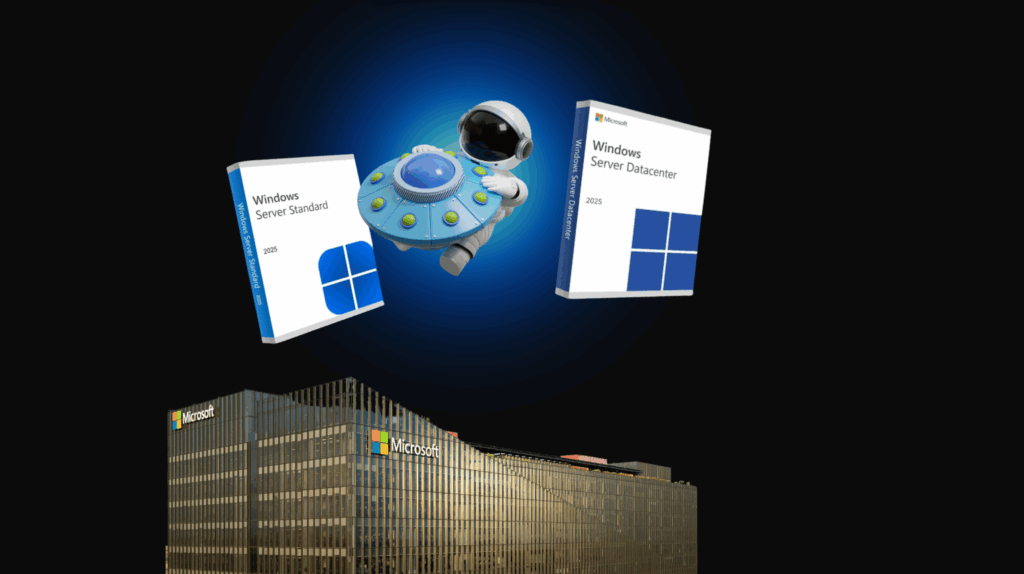Microsoft Windows Server 2025 Licensing Guide

This comprehensive guide is designed to help IT professionals, system administrators, and procurement specialists understand the licensing model for Windows Server 2025. Proper licensing is essential for compliance, cost optimization, and ensuring your organization has the right capabilities to meet its business needs.
Windows Server 2025 is Microsoft’s cloud-ready operating system that enables organizations to securely run their workloads, implement hybrid cloud scenarios, and modernize applications to meet evolving business requirements. It brings advanced security and resiliency, hybrid cloud agility, and a future-ready, high-performance infrastructure.
Key Features of Windows Server 2025
Advanced Multi-layered Security: Windows Server 2025 includes Secured-core server technology, which provides comprehensive protection across hardware, firmware, and virtualization layers. This allows IT and security operations teams to apply advanced protection broadly throughout their environment.
Hybrid Capabilities with Azure: Organizations adopting a hybrid and multicloud approach can leverage cloud services with on-premises Windows Server 2025 by connecting with Azure Arc. Features like Hotpatching are available for on-premises Windows Server 2025 when connected to Azure Arc. File Server enhancements include SMB Compression, which improves application file transfer by compressing data while in transit over a network.
Flexible Application Platform: Windows Server 2025 offers significant scalability improvements, supporting up to 48TB of memory and 2,048 logical cores running on 64 physical sockets for demanding Tier1 applications. It also includes advancements to Windows containers, improving application compatibility, supporting HostProcess containers for node configuration, enabling IPv6 and dual-stack, and allowing consistent network policy implementation with Calico.
2. Windows Server 2025 Editions
Windows Server 2025 is available in three primary editions, each designed to meet specific organizational needs based on size, virtualization requirements, and datacenter complexity.
Datacenter Edition
Ideal for: Highly virtualized and software-defined datacenter environments
Key capabilities:
- Unlimited virtualization rights when licensed based on physical cores
- Software-defined networking and storage features
- Advanced security features
- Shielded virtual machines
- Storage Spaces Direct
- Storage Replica
- Software-defined networking stack
Standard Edition
💡Ideal for: Low-density or non-virtualized environments
Key capabilities:
- Limited virtualization rights (two OSEs or Hyper-V containers when licensed based on physical cores)
- Core Windows Server functionality
- Basic software-defined networking features
Essentials Edition
💡Ideal for: Small businesses with up to 25 users and 50 devices
Key capabilities:
- Simplified interface designed for small businesses
- Integration with Microsoft 365
- Remote Web Access
- Available through OEM channels only
- Limited to a single server with up to 10 cores and 1 VM on single-socket servers
Edition Comparison
| Feature | Datacenter | Standard | Essentials |
|---|---|---|---|
| Licensing model | Per Core/CAL | Per Core/CAL | Server license (OEM only) |
| OSEs/Hyper-V containers (physical core licensing) | Unlimited | Two | One |
| OSEs/Hyper-V containers (virtual machine licensing) | One | One | N/A |
| Windows Server containers | Unlimited | Unlimited | Limited |
| Storage Spaces Direct | ✅ | ❌ | ❌ |
| Storage Replica | ✅ | Limited | ❌ |
| Shielded Virtual Machines | ✅ | ✅ | ❌ |
| Software-defined Networking | ✅ | Limited | ❌ |
| Maximum users | Unlimited | Unlimited | 25 |
| Maximum devices | Unlimited | Unlimited | 50 |
Edition Selection Guidance
Choose Datacenter Edition when:
- You need to run many virtual machines on a few physical servers
- You require advanced software-defined storage and networking features
- You need unlimited virtualization rights
- You have 13 or more OSEs or Hyper-V containers per server
- Choose Standard Edition when:
- You have limited virtualization needs (fewer than 13 OSEs per server)
- You don’t require advanced software-defined datacenter features
- You’re running physical servers or have low VM density
Choose Essentials Edition when:
- You’re a small business with fewer than 25 users and 50 devices
- You need a simple, first-server solution
- You have minimal virtualization needs
3. Core-Based Licensing Model
Windows Server 2025 Datacenter and Standard editions use a core-based licensing model. This model offers two licensing options: licensing based on physical cores or licensing by virtual machine.
Physical Core Licensing
When licensing based on physical cores, you must license all physical cores in the server, subject to the following minimums:
- Minimum of 8 core licenses per physical processor
- Minimum of 16 core licenses per server
For example, if you have a server with 2 processors and 6 cores per processor (12 cores total), you still need to license 16 cores because of the minimum requirement.
Core licenses are sold in packs:
- 2-pack core licenses
- 16-pack core licenses (for convenience, equivalent to eight 2-packs)
Calculating Required Licenses
To determine how many core licenses you need:
- Count the number of physical cores in each processor
- Ensure you’re licensing at least 8 cores per processor
- Ensure you’re licensing at least 16 cores per server
- Calculate the total number of 2-packs or 16-packs needed
Example Scenarios:
| Server Configuration | Required Core Licenses | Required 2-pack SKUs | Required 16-pack SKUs |
|---|---|---|---|
| 1 CPU, 4 cores | 16 cores | 8 | 1 |
| 2 CPUs, 4 cores each | 16 cores | 8 | 1 |
| 2 CPUs, 10 cores each | 20 cores | 10 | 1 + 2 (2-packs) |
| 4 CPUs, 8 cores each | 32 cores | 16 | 2 |
Virtual Machine Licensing
The option to license Windows Server by virtual machine was introduced in October 2022 and is available only to customers with:
- Subscription licenses, or
- Licenses with active Software Assurance
When licensing by virtual machine:
- The number of core licenses required equals the number of virtual cores in the virtual OSE
- Subject to a minimum of 8 core licenses per virtual machine
- Subject to a minimum of 16 core licenses per customer
This licensing option provides more flexibility for environments with varying VM sizes and can be more cost-effective for certain scenarios, especially when VMs have fewer virtual cores.
4. Virtualization Rights
Virtualization rights vary by edition and licensing method. Understanding these rights is crucial for proper licensing and cost optimization.
Datacenter Edition Virtualization Rights
When licensed based on physical cores:
- Run unlimited operating system environments (OSEs) or Windows Server Containers with Hyper-V isolation
- Run unlimited Windows Server containers without Hyper-V isolation
- All physical cores on the server must be licensed (minimum 8 cores per processor, 16 cores per server)
When licensed by virtual machine:
- Run Windows Server in one virtual OSE
- Run one Windows Server container with Hyper-V isolation
- Run unlimited Windows Server containers without Hyper-V isolation in one virtual OSE
- Each virtual machine must be licensed separately
Standard Edition Virtualization Rights
When licensed based on physical cores:
Run two operating system environments (OSEs) or two Windows Server Containers with Hyper-V isolation
- Run unlimited Windows Server containers without Hyper-V isolation
- All physical cores on the server must be licensed (minimum 8 cores per processor, 16 cores per server)
- Can use the physical OSE solely to host and manage virtual OSEs (in addition to two virtual OSEs)
When licensed by virtual machine:
- Run Windows Server in one virtual OSE
- Run one Windows Server container with Hyper-V isolation
- Run unlimited Windows Server containers without Hyper-V isolation in one virtual OSE
- Each virtual machine must be licensed separately
Essentials Edition Virtualization Rights
- Run one instance of the server software in either a physical OSE or virtual OSE
- If using a physical OSE solely to host and manage one virtual OSE, can run in both the physical and virtual OSE
“Stacking” Licenses for Additional OSEs
For Standard edition licensed based on physical cores, you can add virtualization rights by “stacking” licenses. For each additional set of two OSEs or two Hyper-V containers, you must assign an additional set of licenses equal to the number of physical cores on the server.
Example: Standard Edition “Stacking” on a 2-processor server with 8 cores per processor
| OSEs or Hyper-V Containers | Required Core Licenses | Required 2-pack SKUs |
|---|---|---|
| 2 per server (default) | 16 | 8 |
| 4 per server | 32 | 16 |
| 6 per server | 48 | 24 |
| 8 per server | 64 | 32 |
| 10 per server | 80 | 40 |
Alternatively, customers with subscription licenses or licenses with active Software Assurance can license additional OSEs by virtual machine instead of stacking.
Container Licensing
Windows Server 2025 supports two types of containers:
1. Windows Server containers without Hyper-V isolation:
- Standard and Datacenter editions include rights to unlimited Windows Server containers without Hyper-V isolation
- These containers share the kernel of the host operating system
2. Windows Server containers with Hyper-V isolation:
- Each container runs in a highly optimized virtual machine
- Datacenter edition (physical core licensing): Unlimited containers
- Standard edition (physical core licensing): Two containers (plus additional with stacking)
- Both editions (virtual machine licensing): One container per licensed VM
5. Access Licensing
In addition to server licenses, Windows Server 2025 requires access licenses for users and devices that access the server. This is true whether you license Windows Server based on physical cores or by virtual machine.
Client Access Licenses (CALs) Overview
A Client Access License (CAL) is required for each user or device that accesses a Windows Server. CALs are categorized as:
- Base CALs: Required for basic access to Windows Server
- Additive CALs: Required for access to advanced functionality, in addition to Base CALs
User CALs vs. Device CALs
- User CAL: Allows one user to access Windows Server from any device
- Device CAL: Allows any user to access Windows Server from one device
Organizations can choose the most cost-effective option based on their usage patterns:
- Choose User CALs when users access the server from multiple devices
- Choose Device CALs when multiple users share devices (e.g., shift workers)
- Organizations can use a mix of User and Device CALs as needed.
External Connector Licenses
For external users (users who are not employees, onsite contractors, or onsite agents), organizations have two options:
- Purchase CALs for each external user/device, or
- Purchase External Connector (EC) licenses for each server accessed by external users
External Connector licenses are assigned to servers and allow unlimited external user access to that server. Like CALs, External Connectors come in Base and Additive varieties.
Base and Additive CALs
Base CALs and ECs:
- Windows Server CAL
- Windows Server External Connector
Additive CALs and ECs (required in addition to Base CALs/ECs):
- Windows Server Remote Desktop Services CAL/EC
- Windows Server Active Directory Rights Management Services CAL/EC
- Microsoft Identity Manager CAL/EC
Access Licensing Requirements for Internal Users
| Access License | Category | Required for Datacenter | Required for Standard | Required for Essentials |
|---|---|---|---|---|
| Windows Server | Base | CAL | CAL | N/A |
| Windows Server Remote Desktop Services | Additive | CAL | CAL | N/A |
| Windows Server Active Directory Rights Management Services | Additive | CAL | CAL | CAL |
| Microsoft Identity Manager | Additive | CAL | CAL | N/A |
Access Licensing Requirements for External Users
| Access License | Category | Required for Datacenter | Required for Standard |
|---|---|---|---|
| Windows Server | Base | CAL or EC | CAL or EC |
| Windows Server Remote Desktop Services | Additive | CAL or EC | CAL or EC |
| Windows Server Active Directory Rights Management Services | Additive | CAL or EC | CAL or EC |
| Microsoft Identity Manager | Additive | CAL or EC | CAL or EC |
CAL Version Compatibility
CALs and ECs permit access to the same version or earlier versions of Windows Server:
| CAL/EC Version | Windows Server 2025 | Windows Server 2022 | Windows Server 2019 |
|---|---|---|---|
| 2025 CAL/EC | Yes | Yes | Yes |
| 2022 CAL/EC | No | Yes | Yes |
| 2019 CAL/EC | No | No | Yes |
CAL Exceptions and Exemptions
CALs and ECs are not required in the following scenarios:
- Server-to-server communication: When one licensed server accesses another licensed server
- Web workloads: When accessing server software running a web workload (content served within an Internet web solution on a publicly available website)
- High-performance computing (HPC) workloads: When accessing server software used to run a cluster node for HPC applications
- Management OSE: When accessing a physical OSE used solely for hosting and managing virtual OSEs
6. Software Assurance Benefits
Software Assurance (SA) is a comprehensive maintenance offering that provides additional benefits for Windows Server licenses. Organizations with active Software Assurance receive the following benefits:
New Version Rights
Upgrade each product license covered by active Software Assurance to the most recent version when available. This ensures you always have access to the latest features and security updates.
Step-up Licenses
Migrate from a lower-level edition to a higher-level edition (e.g., from Windows Server 2025 Standard to Windows Server 2025 Datacenter) by paying only the difference in license cost. This benefit is not available through the Open License program.
Disaster Recovery Rights
For each instance of eligible server software running in a physical or virtual OSE on a licensed server, you may temporarily run a backup instance in a physical or virtual OSE on either:
- Servers dedicated to disaster recovery and to your use, or
- For instances of eligible software other than Windows Server, on Microsoft Azure Services (managed by Azure Site Recovery to Azure)
The backup instance can run only during:
- Brief periods of disaster recovery testing (within one week every 90 days)
- During an actual disaster, while the production server is down
- Around the time of a disaster, for a brief period, to assist in the transfer between servers
Azure Hybrid Benefit for Windows Server
Upload and use your own Windows Server images on Microsoft Azure through Azure Virtual Machines and pay only for the cost of service utilization. Each Windows Server processor license with Software Assurance, and each set of 16 Windows Server core licenses with Software Assurance, entitles you to use Windows Server on Microsoft Azure on up to 16 virtual cores allocated across two or fewer Azure Base Instances.
Flexible Virtualization Benefit
Expands your outsourcing options for software to include Authorized Outsourcers’ shared servers. This benefit is available broadly for software products under your subscription licenses and licenses with Software Assurance.
License Mobility
Move licenses between servers within your organization or to third-party shared servers. License Mobility rights are available for most server applications but have specific limitations for Windows Server itself.
7. Deployment Scenarios and Licensing Examples
Understanding how to apply Windows Server 2025 licensing to real-world scenarios helps ensure compliance and optimize costs. Here are several common deployment scenarios and their licensing requirements.
Physical Server Deployment
Scenario: A single physical server with 2 processors, 10 cores per processor, running Windows Server 2025 Standard as the host operating system.
Licensing Requirements:
- 20 core licenses (10 cores × 2 processors)
- Windows Server 2025 Standard edition
- Windows Server CALs for each user or device accessing the server
Cost Optimization: If the server has minimal virtualization needs, Standard edition is the most cost-effective option.
Virtualized Environment with Standard Edition
Scenario: A physical server with 2 processors, 8 cores per processor, hosting 6 virtual machines running Windows Server 2025.
Licensing Requirements with Physical Core Licensing:
- Base requirement: 16 core licenses of Windows Server 2025 Standard (covers 2 VMs)
- Additional requirement: 32 more core licenses (16 × 2) to cover the remaining 4 VMs
- Total: 48 core licenses (24 2-packs or 3 16-packs)
- Windows Server CALs for each user or device accessing the VMs
Licensing Requirements with Virtual Machine Licensing (requires subscription or SA):
- 8 core licenses per VM (minimum) × 6 VMs = 48 core licenses
- If VMs have more than 8 virtual cores, license for the actual number of virtual cores
- Windows Server CALs for each user or device accessing the VMs
Cost Optimization: Compare the cost of Standard edition with stacking versus Datacenter edition. If you need more than 12-13 VMs, Datacenter edition becomes more cost-effective.
Virtualized Environment with Datacenter Edition
Scenario: A physical server with 2 processors, 12 cores per processor, hosting 20 virtual machines running Windows Server 2025.
Licensing Requirements with Physical Core Licensing:
- 24 core licenses of Windows Server 2025 Datacenter (12 cores × 2 processors)
- Windows Server CALs for each user or device accessing the VMs
Licensing Requirements with Virtual Machine Licensing (requires subscription or SA):
- 8 core licenses per VM (minimum) × 20 VMs = 160 core licenses
- If VMs have more than 8 virtual cores, license for the actual number of virtual cores
- Windows Server CALs for each user or device accessing the VMs
Cost Optimization: For high-density virtualization, physical core licensing with Datacenter edition is typically more cost-effective than licensing by virtual machine.
Hybrid Cloud Scenario
Scenario: An organization with on-premises Windows Server 2025 deployment wants to extend workloads to Azure.
Licensing Requirements:
- On-premises: Standard or Datacenter edition core licenses as appropriate
- Azure: Can use Azure Hybrid Benefit with Software Assurance
- Each set of 16 core licenses with SA allows up to 16 virtual cores in Azure across 2 VMs
- Each additional set of 8 core licenses allows up to 8 virtual cores and 1 VM
Cost Optimization: Azure Hybrid Benefit can reduce Azure compute costs by up to 40% for Windows Server virtual machines.
Container Deployment
Scenario: A physical server with 2 processors, 8 cores per processor, running 5 Windows Server containers with Hyper-V isolation and 15 Windows Server containers without Hyper-V isolation.
Licensing Requirements with Standard Edition (Physical Core Licensing):
- Base requirement: 16 core licenses (covers 2 Hyper-V containers and unlimited non-Hyper-V containers)
- Additional requirement: 24 more core licenses to cover the remaining 3 Hyper-V containers
- Total: 40 core licenses (20 2-packs or 2 16-packs + 4 2-packs)
Licensing Requirements with Datacenter Edition (Physical Core Licensing):
- 16 core licenses of Windows Server 2025 Datacenter
- Covers unlimited containers of both types
Cost Optimization: If you need more than 6 Hyper-V containers, Datacenter edition becomes more cost-effective than Standard edition with stacking.
Windows Server Pay-as-you-go Scenario
Scenario: An organization with Windows Server 2025 Standard needs temporary additional capacity for a seasonal workload.
Licensing Requirements:
- Base deployment: Standard edition core licenses as appropriate
- Connect to Azure Arc
- Enable pay-as-you-go for additional VMs as needed
- Pay $33.58 per CPU core / monithor $0.046 / hour for the additional capacity
Cost Optimization: Pay-as-you-go provides flexibility for temporary capacity needs without purchasing permanent licenses.
8. Windows Server Pay-as-you-go Option
Windows Server 2025 introduces a new cloud billing option that provides pay-as-you-go flexibility across on-premises and cloud environments.
Overview and Requirements
The pay-as-you-go option allows customers without unlimited virtualization to scale up with additional virtual machines to meet capacity bursts or temporary needs. Key requirements include:
- Windows Server 2025 only (not available for earlier versions)
- Azure Arc connection required
- Azure subscription for billing
Azure Arc Integration
To use the pay-as-you-go option:
- Connect your Windows Server 2025 environment to Azure Arc
- Configure Windows Server pay-as-you-go through the Azure portal
- Deploy additional VMs as needed
- Pay only for what you use
Pricing and Billing
- $33.58 USD per CPU core/month
- $0.046 USD/hour
- Billed through your Azure subscription
- Prices are subject to change and may vary by region
Use Cases and Benefits
- Seasonal workloads: Scale up during peak periods without purchasing permanent licenses
- Development and testing: Create temporary environments without long-term licensing commitments
- Disaster recovery: Quickly deploy additional capacity during recovery scenarios
- Project-based needs: Support short-term projects without capital expenditure
- Capacity planning: Avoid overprovisioning licenses for occasional peak usage
9. Volume Activation
Volume Activation is a set of technologies and tools designed to automate the product activation process for systems deployed under a Microsoft Commercial Licensing agreement. Windows Server 2025 includes several technologies to simplify the configuration, distribution, and management of volume software licenses.
Key Management Service (KMS)
KMS is a role service that allows organizations to activate systems within their network from a server where a KMS host has been installed. Benefits include:
- Activations occur on the local network, eliminating the need for individual computers to connect to Microsoft
- No dedicated system required; can be cohosted on a system providing other services
- Volume editions of Windows client and server operating systems automatically connect to the KMS service
- No action required from the user
Implementation Steps:
- Install the Volume Activation Services server role
- Configure the KMS host
- Ensure client systems can reach the KMS host
- Systems will automatically activate when they contact the KMS host
Active Directory-based Activation
Active Directory-based activation is a role service that allows you to use Active Directory Domain Services (AD DS) to store activation objects, further simplifying volume activation services. Benefits include:
- No additional host server needed
- Activation requests processed during computer startup
- Computers running Windows Server 2016 or later with a Generic Volume License Key (GVLK) activate automatically
- Systems stay activated as long as they remain domain members and maintain periodic contact with a domain controller
Implementation Steps:
- Install the Volume Activation Services server role
- Configure Active Directory-based activation
- Join client systems to the domain
- Systems will automatically activate when the licensing service starts
Volume Activation Services Server Role
The Volume Activation Services server role in Windows Server enables you to automate and simplify the issuance and management of Microsoft software volume licenses. This role allows you to:
- Install and configure KMS
- Enable Active Directory-based activation
- Manage activation for various scenarios and environments
- Track activation status across your organization
10. Licensing Programs and Channels
Windows Server 2025 is available through various licensing programs and channels designed to meet the unique needs of different organizations.
Enterprise Agreement (EA) Options
Enterprise Agreement (EA):
- For organizations with 500+ users/devices
- Three-year agreement with annual payments
- Software Assurance included
- Available for Windows Server Datacenter and Standard editions
Enterprise Agreement Subscription (EAS):
- Subscription-based alternative to EA
- Lower initial costs with annual payments
- Non-perpetual licenses (subscription only)
- Software Assurance benefits included
Server and Cloud Enrollment (SCE)
- An enrollment under the Microsoft Enterprise Agreement
- For organizations standardizing on key server and cloud technologies
- Requires installed base-wide commitment to one or more SCE components
- Provides best pricing and terms, plus other benefits
- Includes cloud-optimized licensing options and simplified license management
Microsoft Products and Services Agreement (MPSA)
- Transactional licensing program
- No minimum purchase requirements
- Software Assurance optional
- Available for Windows Server Datacenter and Standard editions
- Flexible purchasing options
Microsoft Customer Agreement (MCA)
- Modern purchasing agreement that simplifies and consolidates licensing
- Perpetual and subscription options
- Software Assurance optional
- Available for Windows Server Datacenter and Standard editions
- Managed through the Microsoft 365 admin center
Open Value Options
Open Value (OV):
- For organizations with 5+ users/devices
- Three-year agreement with annual payments
- Software Assurance included
- Available for Windows Server Datacenter and Standard editions
Open Value Subscription (OVS):
- Subscription-based alternative to OV
- Lower initial costs with annual payments
- Non-perpetual licenses (subscription only)
- Software Assurance benefits included
OEM Licensing
- Pre-installed licenses with hardware systems
- Available for Windows Server Datacenter, Standard, and Essentials editions
- Tied to the original hardware
- Software Assurance can be added within 90 days of purchase
- Limited downgrade rights compared to volume licensing
Full Packaged Product (FPP)
- Available through online retailers
- Retail box product
- Available for Windows Server Standard edition
- Limited availability and higher per-unit cost
- Best for very small deployments
Services Provider License Agreement (SPLA)
- For service providers offering hosted services to customers
- Monthly subscription model
- Report and pay only for what you use each month
- Available for Windows Server Datacenter and Standard editions
Channel Availability Summary
| Edition | EA/EAS/SCE | MPSA | MCA | SPLA | OV/OVS | FPP/ESD | OEM |
|---|---|---|---|---|---|---|---|
| Datacenter | ✅ | ✅ | ✅ | ✅ | ✅ | ✅ | ✅ |
| Standard | ✅ | ✅ | ✅ | ✅ | ✅ | ✅ | ✅ |
| Essentials | ❌ | ❌ | ❌ | ❌ | ❌ | ❌ | ✅ |
11. Downgrade Rights and License Transitions
Downgrade rights allow you to use earlier versions or lower editions of Windows Server instead of the version you’re licensed for. This provides flexibility when migrating to new versions or when you need to maintain compatibility with existing applications.
Downgrade Rights Explained
When you purchase a Windows Server 2025 license, you have the right to use:
- Earlier versions of the same edition
- Lower editions of the same version or earlier versions
The license terms of the version and edition acquired still govern the use of the software, even when using downgrade rights.
Down Edition Rights
| Licensed Edition | Down Editions Available | Versions Available | Use Rights |
|---|---|---|---|
| Windows Server 2025 Datacenter | Windows Server Datacenter<br>Windows Server Standard<br>Windows Server Essentials | 2022 or earlier | Governed by 2025 Datacenter terms |
| Windows Server 2025 Standard | Windows Server Standard<br>Windows Server Essentials | 2022 or earlier | Governed by 2025 Standard terms |
License Version Compatibility
When using downgrade rights:
- You must have the appropriate media and keys for the version you want to use
- You must comply with the license terms of the version you purchased, not the version you’re running
- The virtualization rights of your purchased license apply, not those of the downgraded version
Transition Paths
Upgrading from Standard to Datacenter:
- With Software Assurance: Use Step-up licenses
- Without Software Assurance: Purchase new Datacenter licenses
Transitioning from physical core licensing to virtual machine licensing:
- Requires subscription licenses or licenses with active Software Assurance
- Can be more cost-effective for environments with few virtual cores per VM
Transitioning from on-premises to cloud:
- Use Azure Hybrid Benefit with Software Assurance
- Consider Windows Server pay-as-you-go for temporary capacity
12. Best Practices and Recommendations
Edition Selection Guidance
Choose Datacenter Edition When:
- You have high-density virtualization (13+ VMs per server)
- You need advanced software-defined datacenter features
- You require unlimited virtualization rights
- You use many Windows Server containers with Hyper-V isolation
Choose Standard Edition When:
- You have low-density virtualization (fewer than 13 VMs per server)
- You don’t need advanced software-defined datacenter features
- You’re running primarily physical workloads
- Budget constraints make Datacenter edition prohibitive
Choose Essentials Edition When:
- You’re a small business with fewer than 25 users
- You need a simple, first-server solution
- You have minimal virtualization needs
Optimizing License Costs
Physical Core Licensing Optimization:
- Consolidate workloads on fewer, more powerful servers
- Use Datacenter edition for servers with high VM density
- Use Standard edition for servers with low VM density
- Consider hardware with higher core-to-performance ratio
Virtual Machine Licensing Optimization:
- Allocate the minimum necessary virtual cores to each VM
- Group VMs with similar workloads to maximize density
- Use subscription or Software Assurance benefits for flexibility
CAL Optimization:
- Choose User CALs when users access from multiple devices
- Choose Device CALs when multiple users share devices
- Consider CAL Suites (Core CAL, Enterprise CAL) for cost savings
- Use External Connector for servers with many external users
Virtualization Strategy
High-Density Virtualization:
- Use Datacenter edition for unlimited virtualization rights
- Consolidate VMs on fewer physical servers
- Implement clustering for high availability
Mixed Virtualization:
- Use Datacenter edition for high-density hosts
- Use Standard edition for low-density hosts
- Consider Windows Server pay-as-you-go for temporary capacity
Container Strategy:
- Use Datacenter edition for extensive use of Hyper-V containers
- Use Standard edition for limited container usage
- Leverage unlimited Windows Server containers without Hyper-V isolation
CAL Management
- Maintain an accurate inventory of users and devices
- Regularly audit CAL compliance
- Consider CAL Suites for comprehensive access rights
- Use User CALs for mobile workforces
- Use Device CALs for shift workers or shared devices
License Compliance
- Document all server deployments and their licensing
- Track virtual machine migrations to ensure proper licensing
- Maintain Software Assurance for maximum flexibility
- Conduct regular licensing audits
- Keep records of downgrade deployments
- Ensure CALs match your server versions
13. Frequently Asked Questions
General Licensing Questions
Q: How are Windows Server Standard and Datacenter editions licensed?
A: Both editions use a core-based license model. You can license based on physical cores or by virtual machine (the latter requires subscription licenses or licenses with active Software Assurance). When licensing based on physical cores, you must license all physical cores on the server, subject to a minimum of 8 core licenses per physical processor and 16 core licenses per server. When licensing by virtual machine, you must license the number of virtual cores in each VM, subject to a minimum of 8 core licenses per VM.
Q: Do the minimum licensing requirements apply to all servers?
A: Yes. When licensing based on physical cores, regardless of the actual number of cores, you must license at least 8 cores per physical processor and at least 16 cores per server. When licensing by virtual machine, you must license at least 8 cores per VM.
Q: Do I have to license all cores on the server, even if they are disabled?
A: Yes, when licensing based on physical cores. All physical cores on all physical processors must be licensed, even if they have been disabled.
Q: Can I split my Windows Server core license packs across multiple servers?
A: Yes. Core licenses are sold in 2-packs and 16-packs, and each individual license may be assigned to a separate physical server.
Virtualization Questions
Q: What are the virtualization rights for Windows Server Standard and Datacenter editions?
A: When licensed based on physical cores, Datacenter edition provides rights to unlimited OSEs or Windows Server containers with Hyper-V isolation. Standard edition provides rights to two OSEs or two Windows Server containers with Hyper-V isolation. When licensed by virtual machine, both editions provide rights to one OSE or one Windows Server container with Hyper-V isolation per licensed VM.
Q: If I have a server licensed for Windows Server Standard, how can I increase my virtualization rights?
A: You have three options:
1.Purchase Step-Up licenses to Datacenter edition (requires Software Assurance)
2.Purchase additional Standard edition licenses to “stack” on the same server
3.License additional virtual machines individually (requires subscription or Software Assurance)
4.Use Windows Server pay-as-you-go through Azure Arc for temporary capacity
Q: How do I determine whether Standard or Datacenter edition is more economical?
A: For servers running 13 or more OSEs or Windows Server containers with Hyper-V isolation, Datacenter edition is typically more cost-effective. For servers running fewer than 13 OSEs or containers, Standard edition is usually more economical.
CAL Requirements
Q: Are CALs required for access to Windows Server Standard and Datacenter editions?
A: Yes, server software access requires either Client Access Licenses (CALs) or External Connectors (ECs), regardless of whether you license based on physical cores or by virtual machine.
Q: Which access licenses do I use to access Windows Server?
A: Windows Server CALs and External Connectors permit access to the same version (or earlier versions) of Windows Server. Each user or device accessing the server requires a Windows Server CAL, or you can purchase an External Connector for each server accessed by external users.
Q: Are there any exceptions to the CAL and External Connector requirements?
A: Yes, CALs and External Connectors are not required for:
•Access by another licensed server
•Access to server software running a web workload or HPC workload
•Access to a physical OSE used solely for hosting and managing virtual OSEs
Cloud Deployment Questions
Q: Can Windows Server licenses be moved between my on-premises servers and Azure?
A: Yes. Customers can deploy on-premises images in Azure using the Azure Hybrid Benefit.
Q: Can Windows Server images be used in Azure under the Azure Hybrid Benefit?
A: Yes. Under the Azure Hybrid Benefit, customers with Windows Server licenses covered with Software Assurance may upload and use their own Windows Server images on Azure and pay only for the cost of service utilization.
Q: Are CALs required for Windows Server instances running on Azure?
A: Base access licenses (CALs and External Connectors) are not required for use of Windows Server on Microsoft Azure. However, Remote Desktop Services (RDS) CALs are required when using corresponding functionality.
Q: Am I permitted to move Windows Server licenses to other cloud providers’ environments?
A: Yes. Windows Server subscription licenses or licenses with active Software Assurance allocated by virtual machine may be moved to Authorized Outsourcers’ clouds (on shared or dedicated servers). An Authorized Outsourcer is generally any cloud provider who is not a Listed Provider or using a Listed Provider for data center services.
14. Glossary of Terms
License: The right to download, access, install, and use a product.
Physical processor: A processor in a physical hardware system.
Physical core: A core in a physical processor.
Server: A physical hardware system capable of running server software.
Licensed server: A single server, dedicated to customer use, to which a license is assigned.
Operating system environment (OSE): All or part of an operating system instance, or all or part of a virtual operating system instance which enables separate machine identity or separate administrative rights, and instances of applications configured to run on the operating system instance.
Physical OSE: An OSE configured to run directly on a physical hardware system.
Virtual OSE: An OSE configured to run on a virtual hardware system.
Hyper-V container: A feature of Windows Server that utilizes a virtual operating system environment. Each Hyper-V container is considered to be one virtual OSE.
Windows Server container: A feature of Windows Server software that shares the kernel of the host operating system.
Client Access License (CAL): A license that allows access to server software, assigned by user or device.
External Connector license: A license assigned to a server that permits access to the server software by external users.
External users: Users that are not employees, onsite contractors, or onsite agents of the customer or its affiliates.
Web workload: Publicly available web pages, websites, web applications, web services, and/or POP3 mail serving.
High-performance computing (HPC) workload: A workload where the server software is used to run a cluster node and support clustered HPC applications.
Authorized Outsourcer: Any third-party service provider that is not a Listed Provider and is not using a Listed Provider as a Data Center Provider.
Resources
Microsoft Licensing Resources
Windows Server Licensing Resources
Microsoft Licensing Resources and Documents
Microsoft Commercial Licensing
Technical Documentation
Windows Server 2025 Documentation
Azure Hybrid Benefit Documentation
Windows Server Pay-as-you-go Documentation
Support Contacts
Volume Licensing Service Center
This guide is for informational purposes only and does not supersede or replace any documentation covering Windows Server 2025 licensing. Specific license terms are defined in the Microsoft Commercial Licensing Product Terms, the Microsoft Commercial Licensing agreement under which it was acquired, and/or its original equipment manufacturer (OEM) or Retail Software License Terms. This licensing guide is not a legal use rights document. Program specifications and business rules are subject to change.








